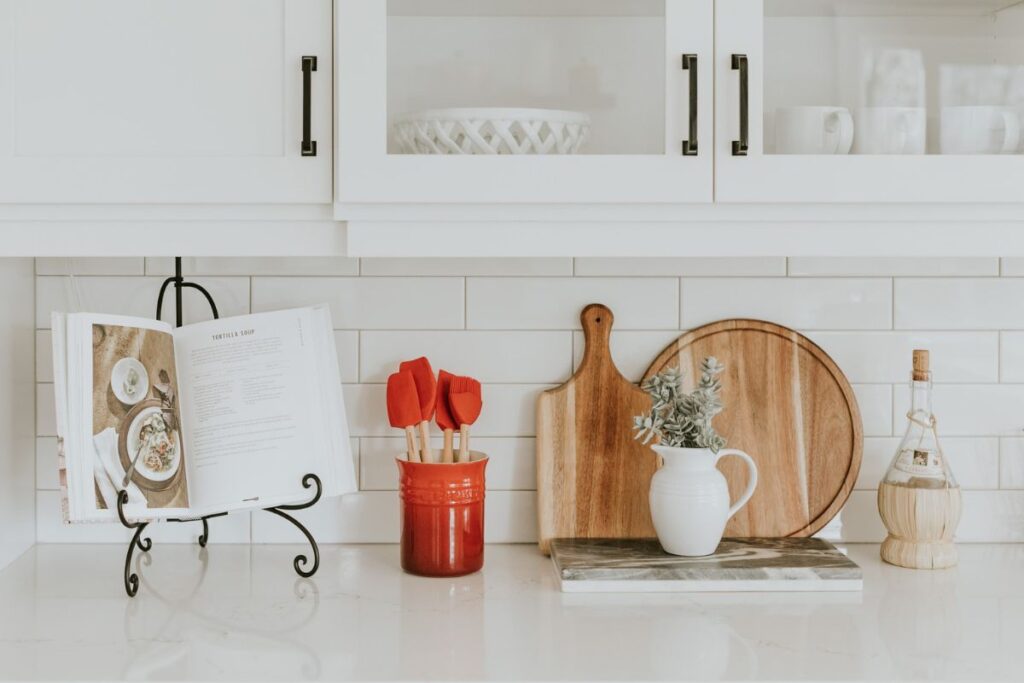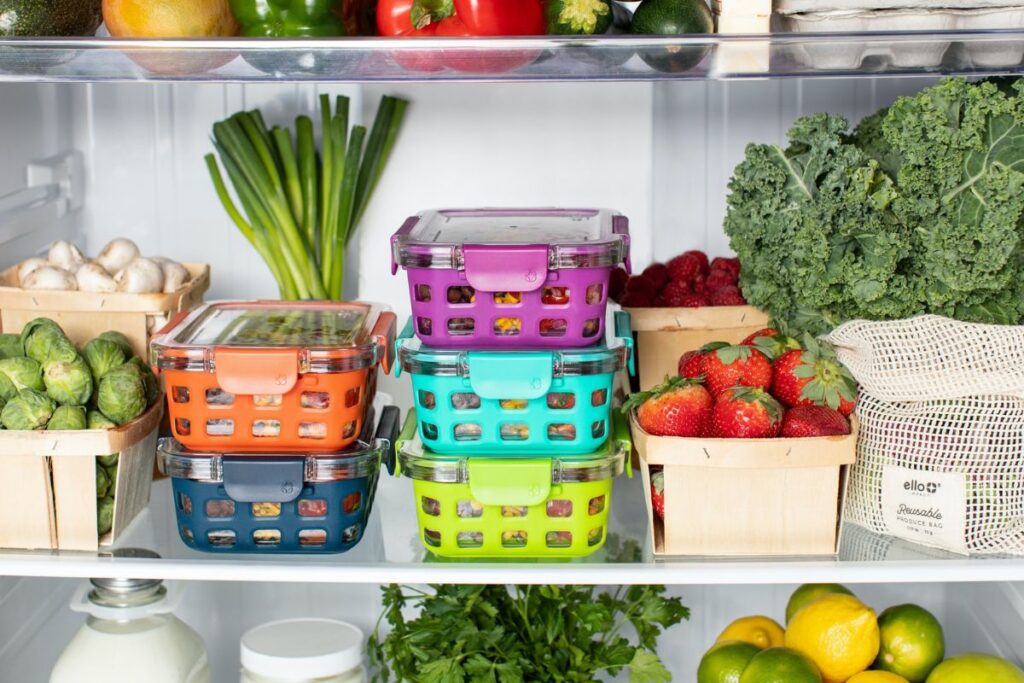Inside: Use these tips to maintain a clutter-free kitchen that functions well for you and your family.
A guest post by Rose Morrison
The kitchen is one of the most essential rooms in the house. In fact, one survey by NDP Group found that 82% of Americans prepare meals at home – and even if people decide to grab takeout, many bring it home to eat.
Understandably, the kitchen sees a lot of foot traffic throughout the day. From preparing the three essential meals to grabbing snacks or doing homework and paying bills, countertops and cabinets tend to get cluttered.
A messy kitchen can make cooking difficult and requires a plan for better organization. For example, if you have too many things on the counter with no room to make dinner, or your pots and pans are inconveniently stored in the farthest cabinet away from the oven, it may be time to make a few changes.
Here are eight golden rules that will help you to maintain a clutter-free kitchen so that it becomes a room you enjoy using!
8 Rules to Maintain a Clutter-Free Kitchen
No one needs added stress when it comes to using their kitchen. Clutter can make it difficult to find items and to use the space you have efficiently.
After you’ve invested the time to declutter your kitchen, you want to keep it that way. Use these eight golden rules to maintain a clutter-free kitchen.
1. Consider What You Use the Most

A toaster holds little value for you if you haven’t made toast in months. The same could be said for a juicer if you rarely juice or a Keurig when you prefer to use a traditional coffee maker for your morning brew.
Ask yourself whether the items in front of you make little difference in improving the functionality of your kitchen. If not, they can probably go away or at least not take up valuable counter space. This includes decor that doesn’t serve a purpose aside from collecting dust.
One way to determine which items are most important to you is to remove everything from cabinets and drawers and sift through them one at a time. Although you don’t need to necessarily throw anything away, considering what serves the most significant purpose is the first step.
2. Only Keep What You Need

On the other hand, you may have one too many spare items piling up. A peek into your upper cabinets could reveal more plates and mugs than you need. Meanwhile, too many forks and knives may get stuck in the track when you open and close the utensil drawer.
If you have excessive dishes, silverware, or utensils, feel free to let go of the items you aren’t using. Options to consider include: mismatched pieces, chipped dishes, damaged items, and duplicates. How many of your spatulas do you really use?
Specialty gadgets and appliances are another category to carefully consider. If you have a bread maker and never make bread, let it go. You also likely don’t need to keep that quesadilla maker. Be realistic with how often you actually use what you have.
Not every popular kitchen gadget works for every household, so even if your aunt or friend swore it would change your life, but you never use it, you don’t need to keep it. These items often take up a lot of space so if it’s not earning its keep, now is a good time to let it go. And feel free to get rid of the as seen on tv gadgets that looked better in the infomercial than they do in real life.
3. Go Minimal

It may not be what you want to hear, but the kitchen is a cesspool of germs and bacteria. For example, salmonella, E. coli, and other microbes easily spread across surfaces when you prepare meat.
Additionally, researchers recently found that a used kitchen sponge contains 54 billion bacteria per cubic centimeter – which many people use continuously to wash dishes, the sink, countertops, and other surfaces.
When decluttering your kitchen, minimal items give your counters a more aesthetically pleasing look while also reducing the amount of surfaces germs can spread to. Of course, this is crucial for ensuring health and safety during food preparation.
Store items in cabinets and drawers and make a conscious effort to move dirty dishes from the sink to the dishwasher at the end of the day. Maintaining a minimalist kitchen will make it easier to keep clean.
4. Keep the Essentials Visible

How many times have you purchased ingredients for a recipe only to discover you had two unopened packages in the back of the pantry or refrigerator? It happens more often than you’d think.
Take spices, for example, which are some of the most disorganized kitchen ingredients. If you want to improve the practicality of your kitchen, you have to keep the essential cookware and ingredients visible at all times.
A utensil crock near the stove is perfect for housing your favorite tongs and wooden spoons, making it easy to grab what you need before your food burns in the pan.
You might even stow an olive oil dispenser bottle alongside the salt and pepper shakers if you start every dish with those particular elements.
As for spices, a small rack won’t take up a lot of space, but it’ll help you regularly take stock of what you have and when you’ll need more. If you have the room for it, a spice drawer is a great option as well.
If you ever host for the holidays, cooking can become stressful and overwhelming. Having a clutter-free kitchen will help you to use your space more efficiently with tools that are easy to find.
5. Improve Cookware Accessibility

Do you have a special skillet you prefer using? Maybe you have a particular knife that you consider a go-to essential.
Similar to keeping frequently used items and ingredients visible, improving the accessibility of specific cookware will make it much easier to maintain a clutter-free kitchen.
We can’t always help an impractical layout – some people purchase their homes with a kitchen that had little thought put into its functionality. However, we can utilize the space we’re given by placing items exactly where we need them.
Aim to store your pots and pans in a cabinet close to the stove while positioning dinner plates, bowls, and utensils near the dishwasher or sink.
When kitchenware is accessible and placed where it’s most convenient, there’s less chance of items moving around to other locations.
6. Optimize Storage

A helpful way to declutter your kitchen is by optimizing storage space. For example, drawer organizers and plastic bins are helpful for separating utensils or tidying the refrigerator.
Some other ways you might improve your kitchen’s storage include the following:
- Store salad dressings, yogurts, and other similar items in plastic bins to keep refrigerator shelves clean.
- Purchase a drawer knife block to store and organize sharp culinary knives safely.
- Mount a cutting board holder on the back of a cabinet door.
- A pull-out cabinet organizer comes with adjustable shelves and can hold spices, oils, and other ingredients.
- Put a lazy susan in a tight corner. These are perfect for holding the utensil crock, shakers, and olive oil dispenser bottle mentioned above.
- Pull-out shelves in the pantry and cabinets make grabbing cookware and packaged items easier without creating a mess.
7. Decant and Label Foods

Neatness counts in a clutter-free kitchen, but you can still decorate sensibly.
Food packaging is somewhat unattractive, but you can swap out cardboard and plastic bags for airtight decanters to create an organized display. Decant rice, pasta, sugar, or other ingredients in glass jars that look great in a pantry or even decorate a small area of the kitchen counter, island, or windowsill with a few.
Be smart about transferring food to a decanter and decide whether the jars can hold everything when sealed. Also, square containers fit next to each other better than round jars, maximizing pantry space more efficiently.
You might also want to invest in a label maker or mark the containers with the ingredient it’s holding. Imagine accidentally grabbing the salt instead of sugar in a cookie recipe.
You don’t have to decant everything in your pantry though. Decanting does take extra time and effort, so start with some basic things, such as baking ingredients, and see how it goes before applying it to other foods.
8. Check for What Doesn’t Belong

Bad habits like tossing the mail on the kitchen counter when you get home from work is tempting. It’s also common for non-kitchen items – pens, staplers, notepads, and scissors – to wind up in drawers or a corner until you remember returning them to the office.
Maintaining a clutter-free kitchen requires you to be mindful of the items that don’t belong. A small basket is one way you can collect errant stuff when you’re finished using them. That way, rather than shoving things in a designated junk drawer, you can place them in the basket until the evening.
Creating ongoing decluttering habits will help to prevent kitchen clutter from piling up so that you’re free to use the space to cook, bake, and prepare food.

Use These Tricks to Maintain a Clutter-Free Kitchen
Your kitchen has the potential to look more aesthetically pleasing and feel more functional when you follow these eight clutter-free rules. It may take a bit of effort to get yourself organized and into the habit of clearing space, but it’ll be worth it when you have less stress and more room to cook.
What’s your favorite tip to maintain a clutter-free kitchen? Share it in the comments section!
Sign up on the form below to get weekly decluttering tips and inspiration sent straight to your inbox. You’ll also get the free 5 Areas to Declutter in 10 Minutes Checklist to help you get started decluttering today.



I have stations….like a coffee station where I keep my coffeemaker, brother, and cinnamon. Very convenient.
should be frother, not brother
i was wondering if the brother was the one making the coffee daiy~ if so does it pay well? lol 🙂
I was thinking your brother must be a voracious coffee drinker😂
I’m just getting into my decluttered home, but running the dishwasher virtually every night has been a game-changer. Admittedly I feel a little guilty because it’s not usually completely full, but it’s worth it for my mental health. In general I try to be fairly conservation-minded but sometimes I have to compromise.
I do any needed hand-washables then start it at bedtime, empty it while I make coffee, add detergent and then fill it throughout the day. If there are any wet dishes in the morning I just put them on the drying rack then put them away when I make dinner. I wish I’d known how much better this would be!
I have a small galley kitchen,I’m always trying to declutter. One thing I never do is leave anything in the kitchen sink during the day or night. Dishwasher goes on at night. Cabinets are another thing, I have glass so my dishes always look good. The other cabinets are a mess, I just shove groceries in them, about once a year I clean them out and start over. Of course I’m 77 yrs old now but I do my best.